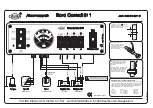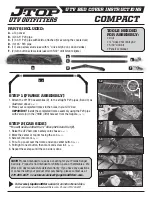
Riding Strategies
Chapter 8
15
Trail Riding
Plan your ride carefully; do not take a trail that requires skill and tech-
niques beyond your abilities or the capabilities of your ATV. Ensure that it
is legal to ride your ATV on trails open to the public or that you have the
owners permission to ride through private land. Be careful going from a
sunny to shaded trail. Ruts or rocks may “hide” in the shade and your
eyes may not adjust quickly enough to see them in time. Gradient lenses
can also help in these conditions. Standing up in the footrests will aid
your ability to take on rough terrain. Remember, be prepared to meet
oncoming traffic as most trails allow two-way travel.
Most properly designed trails are “off-cambered” to allow rain run off.
This means you will need to keep your weight shifted into the slope.
If you must ride at night, be sure both headlight and taillight are work-
ing. Never stop just before a turn on the trail; pull well off the trail when
you stop for a break. Be highly visible to other trail-riders. At night if stop-
ping on the trail, turn a light on so that other riders will see you.
Know Where You Are Riding
If you are planning to ride in an unfamiliar area, contact local organiza-
tions like a motorcycle club, horse riding club and the local Parks and
Wildlife authorities to ensure you know which areas are ok to ride and
which areas you should stay clear of.
Crossing Roads and Highways
ATVs are designed to be used OFF-ROAD ONLY. But on occasion you
may find it necessary yo cross a road or highway. This is common in
farming areas where ATVs are used for various work purposes. If you do
need to cross public roads ensure that you seek permission from the
relevant authorities. A leading cause of accidents and fatalities to ATV
riders is from riding on or crossing the road illegally or improperly. The
hazards of road crossing cannot be over-emphasized. Your ATV will han-
dle differently on pavement and may be difficult to manoeuvre. Besides
using caution and courtesy, follow your state’s laws to cross a road and
ensure you have the legal permission to do so. If you must cross a road,
use the following guidelines:
•
Bring your ATV to a complete stop on the shoulder of the road. If you
are riding in a group, have the first rider (leader) dismount and watch
for traffic as he waves the group across the road. Have the last rider
dismount after crossing and watch traffic for the group leader.
•
Yield the right of way to all oncoming traffic. Look both ways.
•
Cross the road at a 90 degree angle where there are no obstructions
and your visibility is good.
•
Make sure you know your state’s laws and legal procedures before
you cross any road.
•
Remember, crossing roads improperly or illegally riding on the road is
a major cause of serious accidents and fatalities to ATV users, so use
extra caution.
Always assume that drivers DO NOT SEE YOU, since most drivers look
for cars, not ATVs.
Riding Different Terrain
Sand Dunes
Dune riding offers great thrills and fun, but certain safety precautions
are necessary to fully enjoy this type of terrain. Make sure your ATV is
equipped with an antenna flag so others can see you better. The safety
flag should be a bright colour and the antenna at least 3 metres from
ground to tip (with the tip lighted at night).
Dunes shift in size and shape. Drop offs can be created in a matter of
hours. NEVER assume that what you rode on yesterday will be the same
today. When the wind blows, the tracks you left ten minutes ago could
vanish; the path you travelled a few hours ago can require a completely
different riding strategy. Assume wet sand is unstable and could be
quicksand. Do not attempt a crossing unless you know it is a safe area.
Avoid riding on vegetation since it helps stabilise the dunes and may also
hide an obstacle or hazard. Be aware of “slip face” dunes which have a
gradual incline on one side (usually the windward side) and nearly a
straight drop-off on the other side (leeward). Be careful of “razorbacks”
which have a steep angle on both sides. When riding up a dune be pre-
pared to make a U-turn if there is a drop-off. Dunes may vary in shape,
size and direction. Learn the characteristics of the dune system in which
you are riding.
Be extra careful when the sun is directly overhead because there are
no shadows to indicate holes, drop-offs or changes in terrain. A three-to-
four inch heat haze can appear on top of the sand on warm, sunny days,
creating an illusion that the surface is level where instead large bumps
and holes may exist. A wise rider will travel slower under these condi-
tions. A gradient (dark at top and clear at bottom) or dark lens in your
goggles can help distinguish dips, drops and holes in the sand. Wear only
clear lenses at night. Remember, night riding demands extra caution; it is
best to slow down. When stopping for a rest, day or night, park at the
crest of a dune. You will be more visible and have a better view.
Riding Through Mud and Water
Your ATV is equipped to ride through mud and shallow water, but you
should avoid water crossings where you might cause damage to
streambeds, fish spawning grounds, or where you might cause erosion to
the banks of a stream or creek. This precaution not only adds to your own
personal safety and fun, but it preserves the environment for others to
enjoy as well. If you are riding through mud and water, remember the
footrests may become slippery. Remember, water levels may change
from hour to hour. Safely determine the depth of the water or mud before
riding through it. If in doubt, push a long stick into the water to help you
determine its depth.
Never operate your ATV in fast flowing water or in water deeper than
that specified in your owner’s manual. Check you owner’s manual to find
out the maximum depth your ATV can negotiate safely.
If you cross a stream, or go up and down stream banks, use an estab-
lished ford or ride where the banks have a gradual incline. This will help
minimise the impact on the stream bank.
Your body position is very important when riding in mud or water. To
maintain proper balance or maximum traction, be prepared to shift your
weight in any direction. You may find it necessary at times to rock the ATV
from side to side to work it out of a hole. Remember to continue to search
and scan as you ride through mud or water; watch carefully for sub-
merged obstacles.
Proceed at a slow steady speed, avoiding obstacles and slippery
rocks. Do not ride through unfamiliar water too quickly. Mud and deep
water may slow the ATV abruptly and could cause a loss of control if you
enter too swiftly.
Use a moderate speed with higher than usual engine speed.
Remember that wet brakes may have reduced stopping ability. Test your
brakes after leaving water. If necessary, apply them several times to let
friction dry out the linings.
After riding in water, be sure to drain any trapped water by removing
the drain screws (if equipped, check your owner’s manual.) Clean your
ATV with fresh water if you have ridden in or near seawater.
To prevent loss of traction in mud or snow, allow the tyres to rotate at
a speed that enables their knobs to “bite”. Do not spin the tyres quickly;
they will only dig a hole, splatter you with mud, and you will not travel any
faster. Watch for mud build up on the engine, chain, and the rest of the
ATV.











































